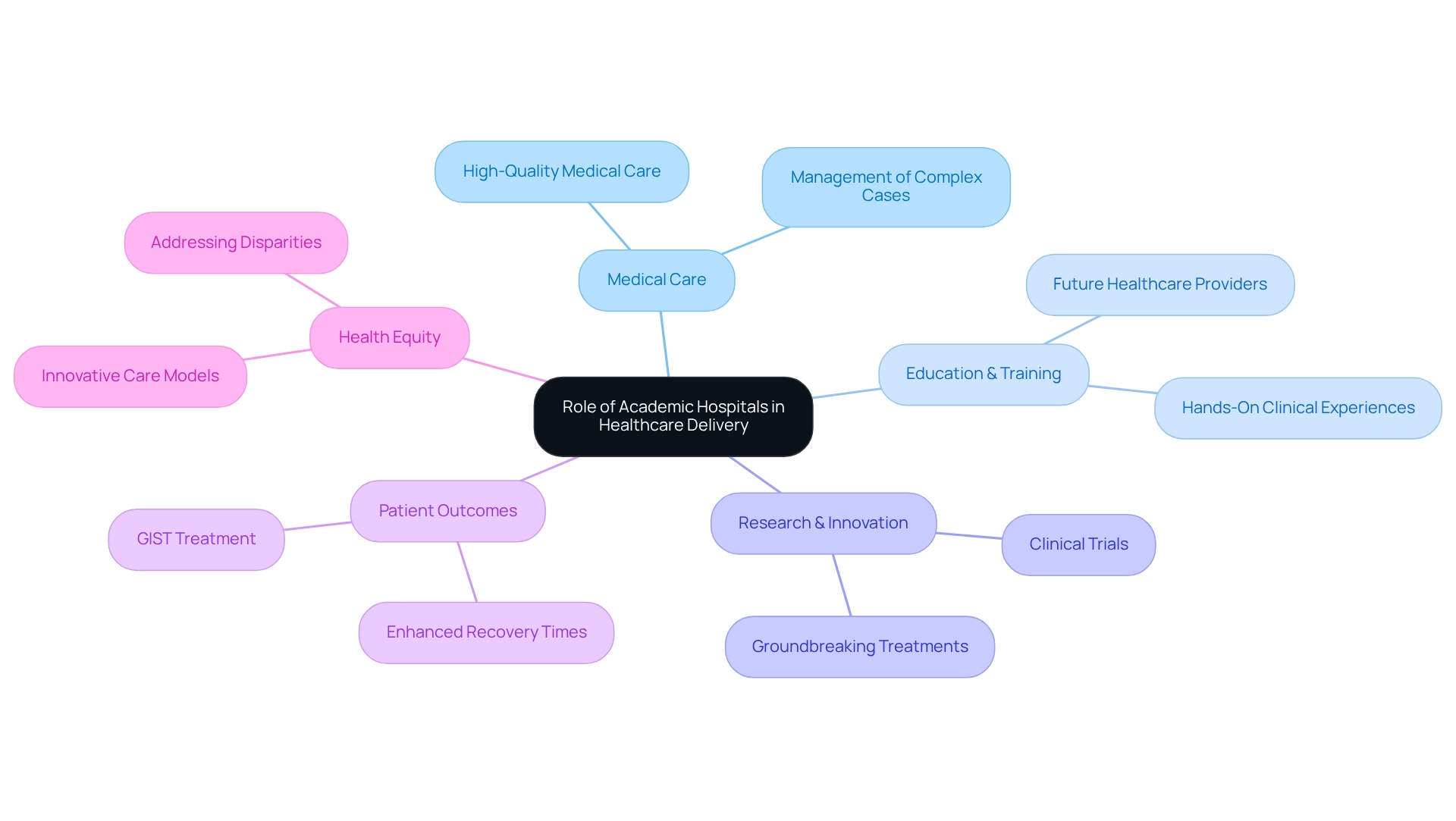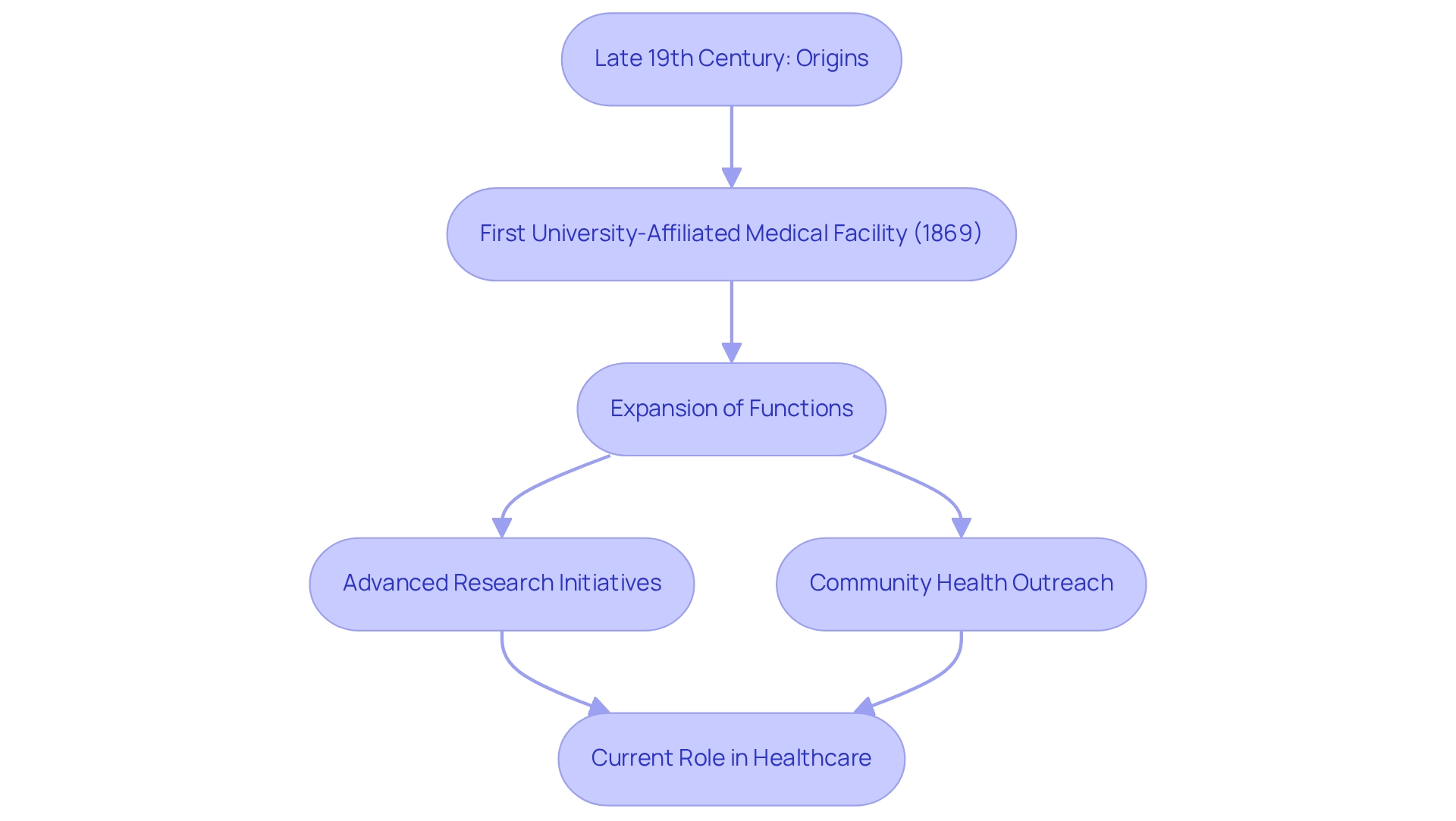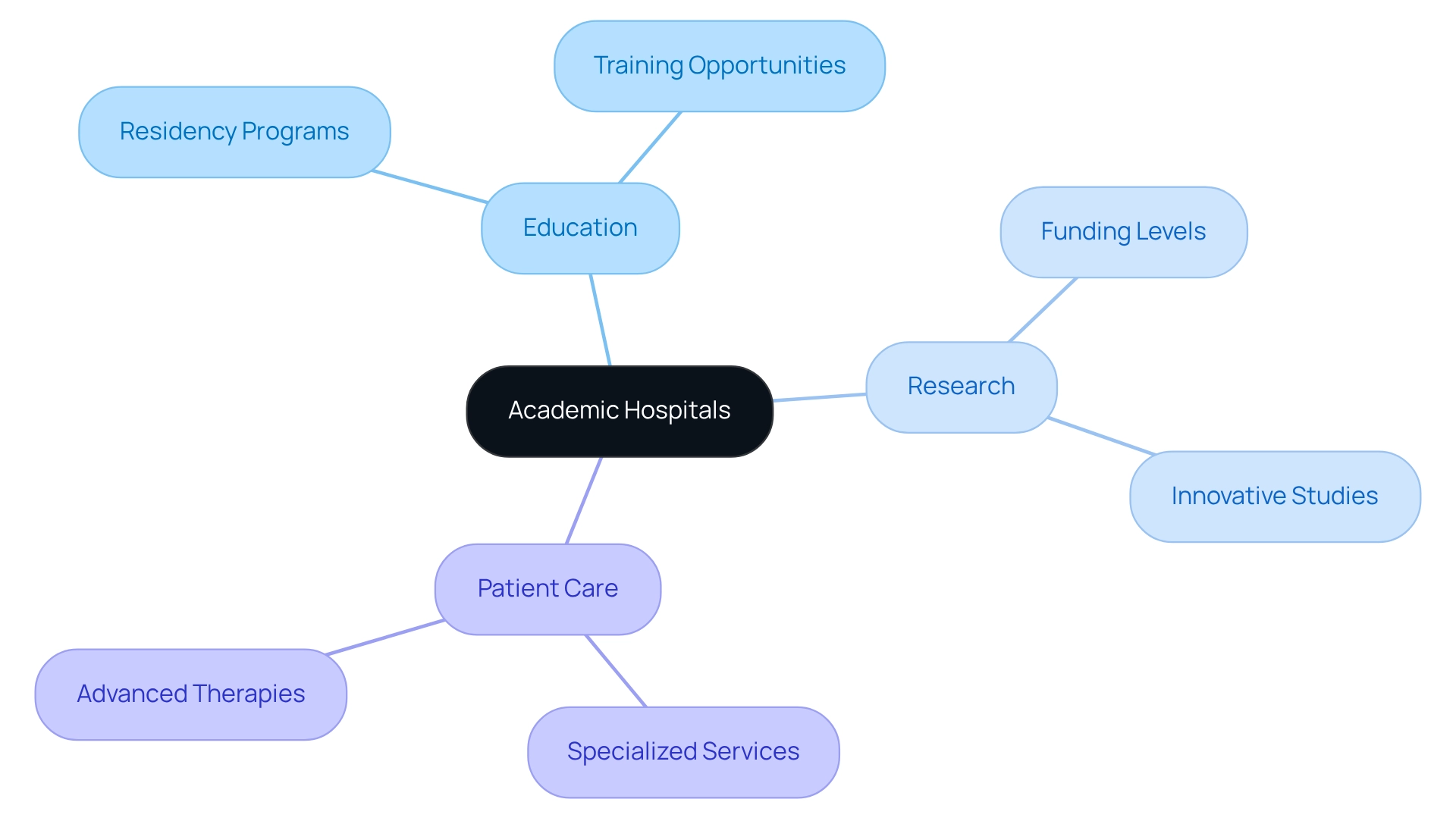Overview
Academic hospitals, also known as academic medical centers (AMCs), are pivotal institutions characterized by their integration of clinical services, education, and research. This unique triad positions them as essential providers of specialized medical care and as training grounds for the next generation of healthcare professionals. Their role extends beyond traditional healthcare delivery; they significantly enhance patient outcomes through:
- Advanced treatment options
- Participation in clinical trials
- An unwavering commitment to quality care
The impact of AMCs on healthcare delivery and innovation is profound, underscoring their importance in the evolving landscape of medical services.
Introduction
In the intricate landscape of healthcare, academic hospitals emerge as beacons of innovation and excellence, seamlessly intertwining patient care, education, and research. These institutions, often affiliated with medical schools, serve not only as vital training grounds for future healthcare professionals but also as pioneers in the development of groundbreaking treatments.
As the demand for specialized medical care continues to rise, academic medical centers (AMCs) are increasingly recognized for their capacity to manage complex health conditions, improve patient outcomes, and enhance the overall healthcare experience.
This article explores the core characteristics, historical evolution, and essential components of academic hospitals, emphasizing their indispensable role in shaping the future of healthcare delivery.
Define Academic Hospital: Core Characteristics and Functions
An academic hospital, also known as an academic medical center (AMC), is a vital institution that integrates clinical services, research, and education. Typically affiliated with academic hospitals, these centers serve as vital training grounds for future healthcare professionals. Core characteristics of an academic hospital include a strong emphasis on specialized medical care, a commitment to education, and active engagement in clinical research.
In 2025, approximately 60% of academic hospitals are linked with medical schools, underscoring their essential role in medical education. These academic hospitals are equipped to manage complex medical cases and often provide advanced treatment options that are not available in community hospitals. Moreover, academic hospitals play a pivotal role in assisting individuals through their treatment pathways, leveraging extensive Medicare data insights to enhance well-being and ensure successful outcomes.
AMCs utilize ICD, NDC, and HCPCS codes to define interventions and navigate treatment pathways effectively. By examining these codes, AMCs can monitor diagnoses, treatment plans, and outcomes, ensuring that individuals receive suitable support throughout their journey from diagnosis to treatment. The combination of Medicare A, B, and D benefits is vital in this process, as it enables academic hospitals to assist individuals in navigating through different phases of support, ensuring access to essential treatments and services.
Recent trends indicate a growing focus on enhancing client experience, which is crucial for building a more confident client base and improving metrics such as the Net Promoter Score. As Peter Drucker aptly observed, “the standard of service is ultimately shaped by the individual’s viewpoint and experience, not merely by the provider’s intentions.” This emphasizes the significance of AMCs prioritizing user experience in their operations. A case study on quality measurement in academic versus community oncology revealed that while both environments uphold high compliance rates with treatment guidelines, there remains considerable opportunity for enhancement in supportive and palliative processes. This highlights the continuous requirement for quality initiatives within academic hospitals to adapt and improve healthcare services, especially regarding Medicare claims data and treatment approvals.
Furthermore, academic hospitals are increasingly recognized for their contributions to individual well-being through research. Examples include innovative treatment protocols developed from clinical trials that directly improve outcomes for individuals. The combination of clinical support and education within academic hospitals not only promotes a culture of ongoing enhancement but also guarantees that medical professionals are well-prepared to address the changing requirements of individuals. As Charles Darwin stated, “It is not the strongest of the species that survives, nor the most intelligent, but the one most responsive to change.” This flexibility is crucial for AMCs in navigating the complexities of contemporary medical systems, especially as they examine treatment pathways and provider interventions.
In summary, academic hospitals play an essential role in the health system, marked by their dedication to education, research, and the provision of specialized medical services, while also empowering stakeholders with valuable insights into treatment journeys. Moreover, comprehending the financial elements of Medicare Part D Plan approvals is essential for AMCs to enhance treatment options and guarantee that individuals receive the best possible assistance.

Contextualize the Role of Academic Hospitals in Healthcare Delivery
Academic hospitals are essential to medical services, offering specialized support for individuals with complex health issues. These institutions not only deliver high-quality medical care but also function as vital training grounds for future healthcare providers, offering hands-on clinical experiences that shape the next generation of professionals. Their commitment to medical research positions them at the forefront of innovation, as they routinely conduct clinical trials that yield groundbreaking treatments and therapies.
The integration of education, research, and care within academic medical centers cultivates a dynamic environment where advancements in medicine can be swiftly translated into clinical practice. This collaboration is crucial for improving patient outcomes, as research indicates that individuals treated in academic hospitals often achieve better results compared to those in community care centers. For instance, a recent analysis revealed that academic hospitals excel at managing intricate cases, leading to lower mortality rates and enhanced recovery times.
Furthermore, effective utilization of Medicare data, exemplified in case studies such as the oncology treatment Qinlock, illustrates how academic institutions can improve provider engagement. CareSet’s data leadership plays a pivotal role in unlocking valuable insights, enabling medical providers to make timely and informed decisions regarding treatment options, ultimately benefiting patient care. Specific metrics from the case study indicate that leveraging Medicare data has resulted in a 20% increase in timely treatment choices for patients with Gastrointestinal Stromal Tumor (GIST).
Expert perspectives underscore the importance of academic hospitals in advancing health equity and addressing the evolving challenges in healthcare delivery. As Sara Vaezy notes, the focus should be on applying learned lessons to enhance the health system’s mission to serve all individuals effectively and equitably. This viewpoint aligns with the competencies outlined by the Agency for Healthcare Research and Quality, which identified seven critical areas for Learning Health System researchers, emphasizing the need for academic hospitals to embody these capabilities in their operations and research endeavors.
Additionally, insights from Peter Pronovost highlight the necessity of integrating quality care with patient experience, stressing that every interaction within these academic hospitals must prioritize respect and excellence. As we look to 2025, the impact of academic medical centers on individual treatment remains significant, particularly in specialized areas such as oncology, cardiology, and neurology. Their involvement in clinical trials not only enhances medical knowledge but also grants patients access to innovative therapies that may not be available elsewhere.
As medical financing and delivery frameworks evolve, discussions surrounding health equity remain critical, with academic hospitals poised to lead initiatives aimed at addressing these disparities through novel care models and research efforts.

Trace the Historical Evolution of Academic Hospitals
The origins of academic hospitals can be traced back to the late 19th century, a pivotal period when medical schools began forming partnerships with healthcare facilities to elevate clinical training. The establishment of the first university-affiliated medical facility in the United States in 1869 marked a significant milestone, symbolizing the integration of education and medical services. Currently, there are approximately 3,525 community medical facilities in the U.S., underscoring the extensive network within which academic centers operate.
Over the years, the transformations of academic hospitals have been substantial to adapt to the evolving medical landscape. Their functions have expanded beyond traditional patient support to include advanced research initiatives and community health outreach programs. This evolution mirrors broader medical trends, such as the increasing complexity of medical care and a heightened emphasis on evidence-based practices. As Simon Lorenz, co-founder of Klara, noted, “Coming from a family of doctors, I was destined to become a doctor too but became intrigued instead by the business and services aspect of the medical field.” This perspective underscores the shifting nature of medical roles, particularly within academic settings.
Moreover, the film ‘Bending the Arc’ illustrates the impact of academic hospitals on global health, emphasizing their critical role in addressing health disparities and improving care outcomes. As these institutions continue to evolve, they play an essential role in shaping the future of medical services and education.

Examine Key Components of Academic Hospitals: Education, Research, and Patient Care
Academic medical centers are defined by three essential components: education, research, and patient care. Education serves as the cornerstone of their mission, equipping medical students, residents, and professionals through rigorous clinical programs. By 2025, these centers are expected to expand their educational initiatives significantly, with statistics indicating a considerable increase in the number of residency programs and training opportunities available. Research plays an equally crucial role, as these institutions often lead pioneering studies that not only advance medical knowledge but also refine treatment protocols. Current funding levels for research projects in academic hospitals demonstrate a commitment to innovation, with substantial investments aimed at addressing pressing medical challenges. CareSet’s integration of over 100 external data sources underscores the importance of comprehensive information in enhancing care and research efforts within these institutions, particularly through insights into drug utilization and treatment pathways that benefit medical stakeholders. CareSet’s monthly Medicare updates tackle critical questions, such as the diseases providers diagnose and treat, how patients navigate their healthcare experiences, and which treatments receive approval from Medicare Part D Plans. Notably, CareSet identifies 15% more targets and 250% more individuals than leading claims vendors, showcasing the quantitative advantages of their insights.
Patient treatment at academic medical centers adheres to the highest standards, often encompassing specialized services and access to advanced therapies. The integration of education and research into patient care cultivates an environment of continuous learning and innovation, ensuring medical professionals are equipped with the most current knowledge and skills. This synergy not only improves patient outcomes but also reinforces the importance of academic hospitals in enhancing medical standards. Insights from industry leaders, such as Lisa Suennen, emphasize that collaborative efforts within these institutions are vital for navigating the complexities of modern medical care. As Suennen notes, “I don’t believe it’s just to claim that digital wellness hasn’t made an impact […] because I think that part of the issue is the timeframe at which you examine matters […] 5 years in this field is like 5 minutes in other sectors.” This perspective highlights the evolving landscape of medical services and the role of educational medical centers in adapting to these changes.
Furthermore, Dr. Simon Lorenz’s insights on value-focused treatment and the importance of doctor-patient communication further underscore the significance of these components in promoting individual well-being within academic hospitals. CareSet’s monthly Medicare updates deliver essential insights into approved treatments and the patient healthcare journey, illustrating the positive influence of these initiatives on patient care and community health.

Conclusion
Academic hospitals are indispensable to the healthcare system, serving as pivotal centers where education, research, and patient care converge. Their focus on specialized medical treatment enables them to adeptly manage complex health conditions, leading to superior patient outcomes compared to community hospitals.
Since their establishment in the late 19th century, academic hospitals have undergone remarkable evolution, broadening their roles to encompass innovative research and community outreach. The application of data analytics, such as those from CareSet, significantly enhances their capacity to make informed decisions that optimize patient navigation and treatment effectiveness.
As the healthcare landscape continues to evolve, academic hospitals are uniquely positioned to address health disparities and champion equity. Their unwavering commitment to education and research keeps them at the cutting edge of medical advancements, equipping future healthcare professionals to address the diverse needs of patients. By prioritizing patient experience and quality of care, academic medical centers not only achieve their mission but also set benchmarks for excellence in healthcare delivery. The ongoing transformation of these institutions is vital for shaping the future of medicine and enhancing health outcomes for all.


